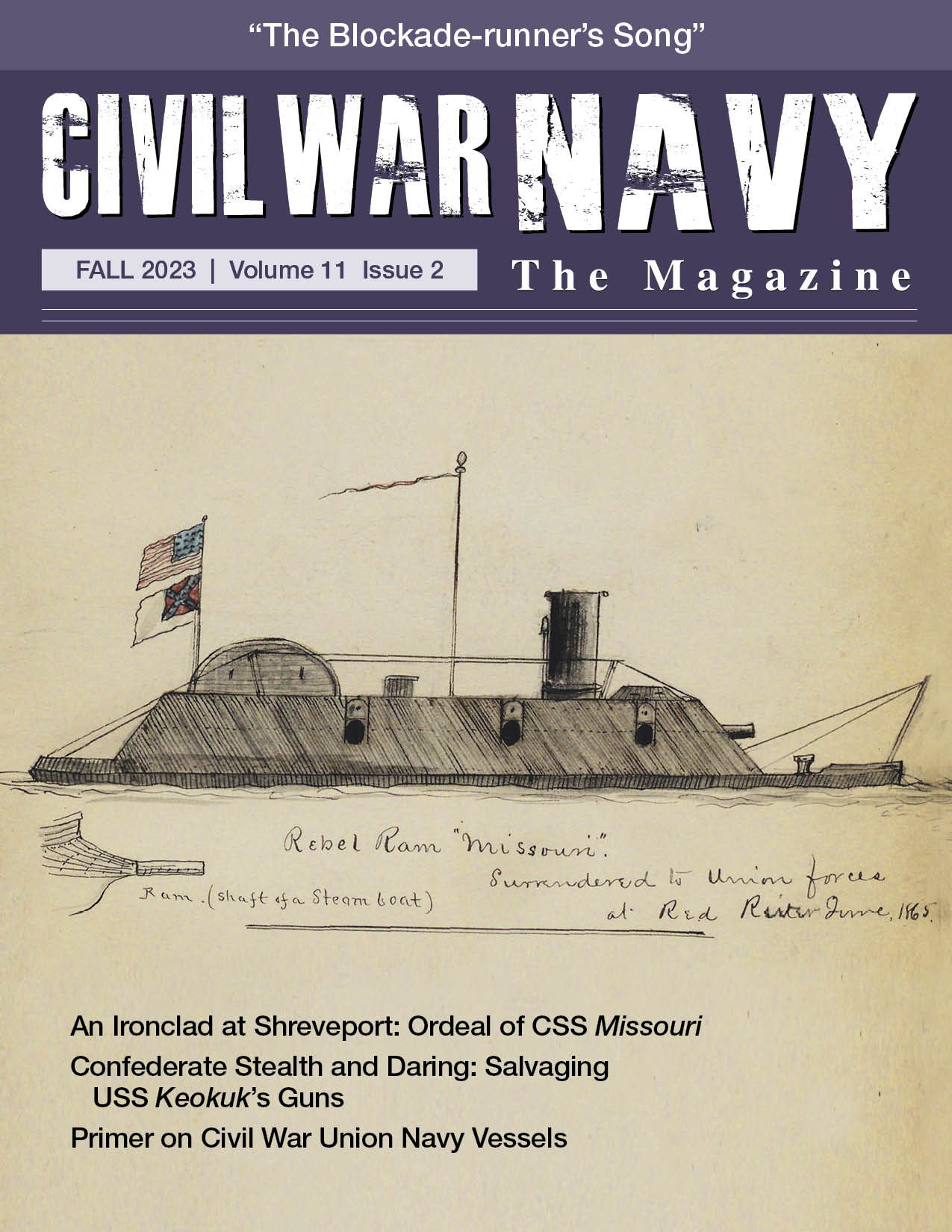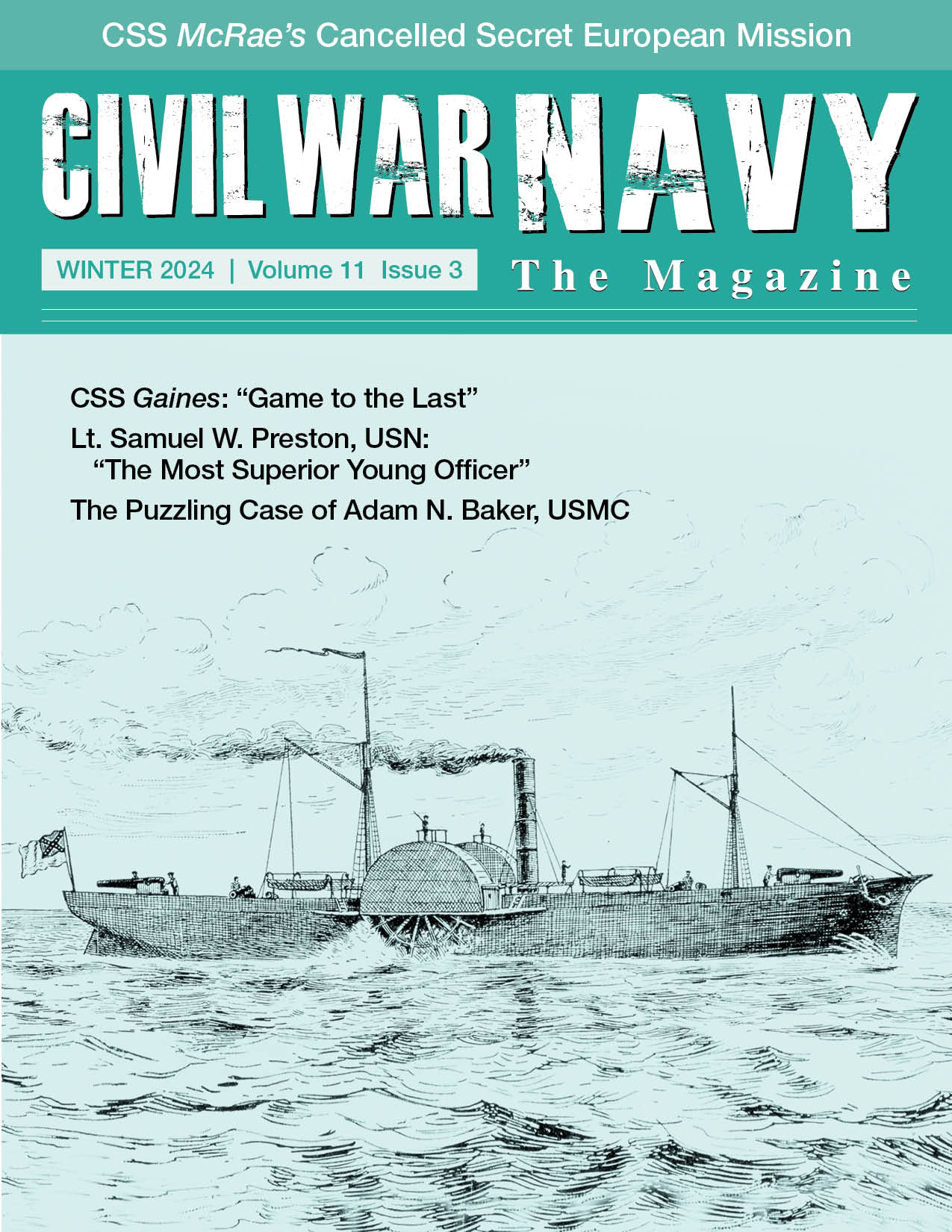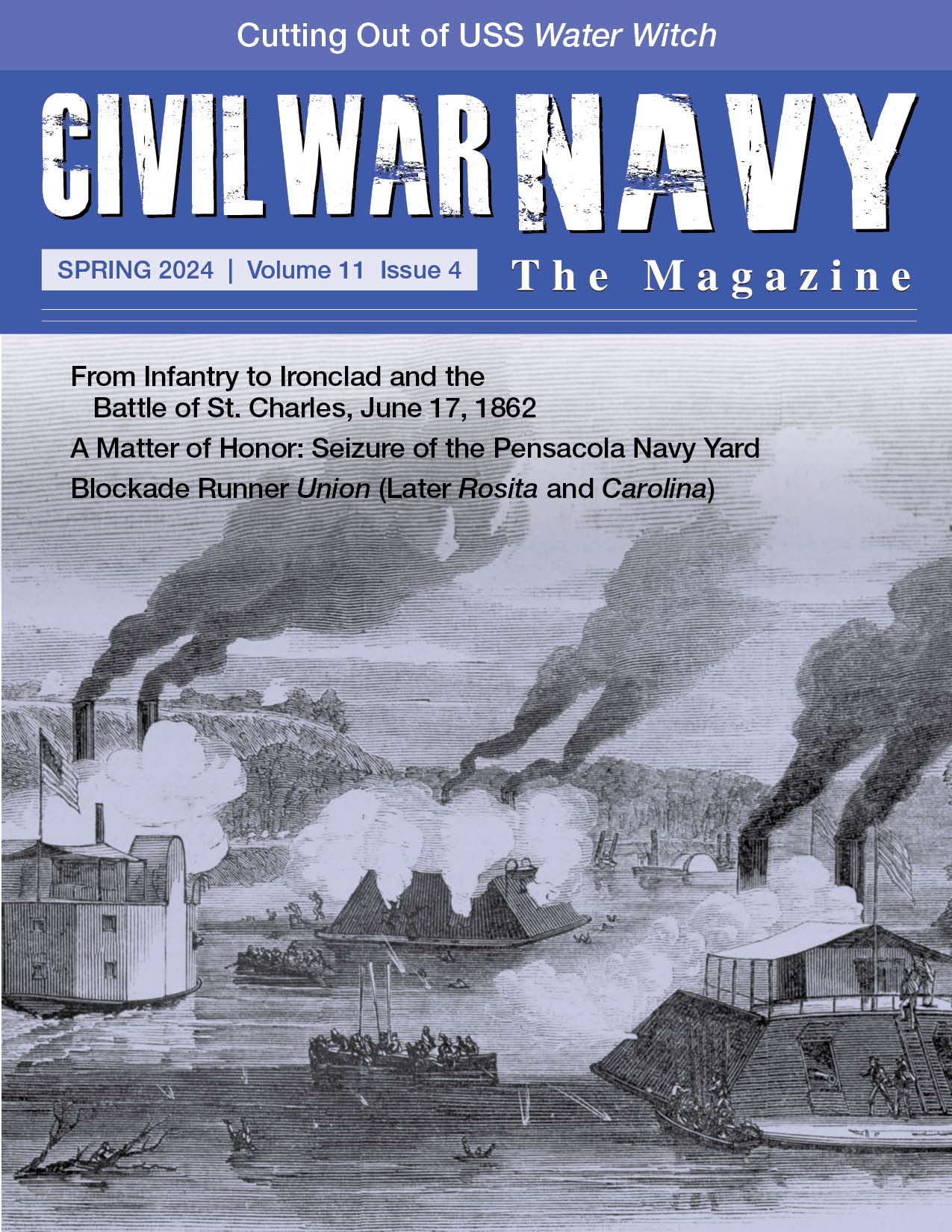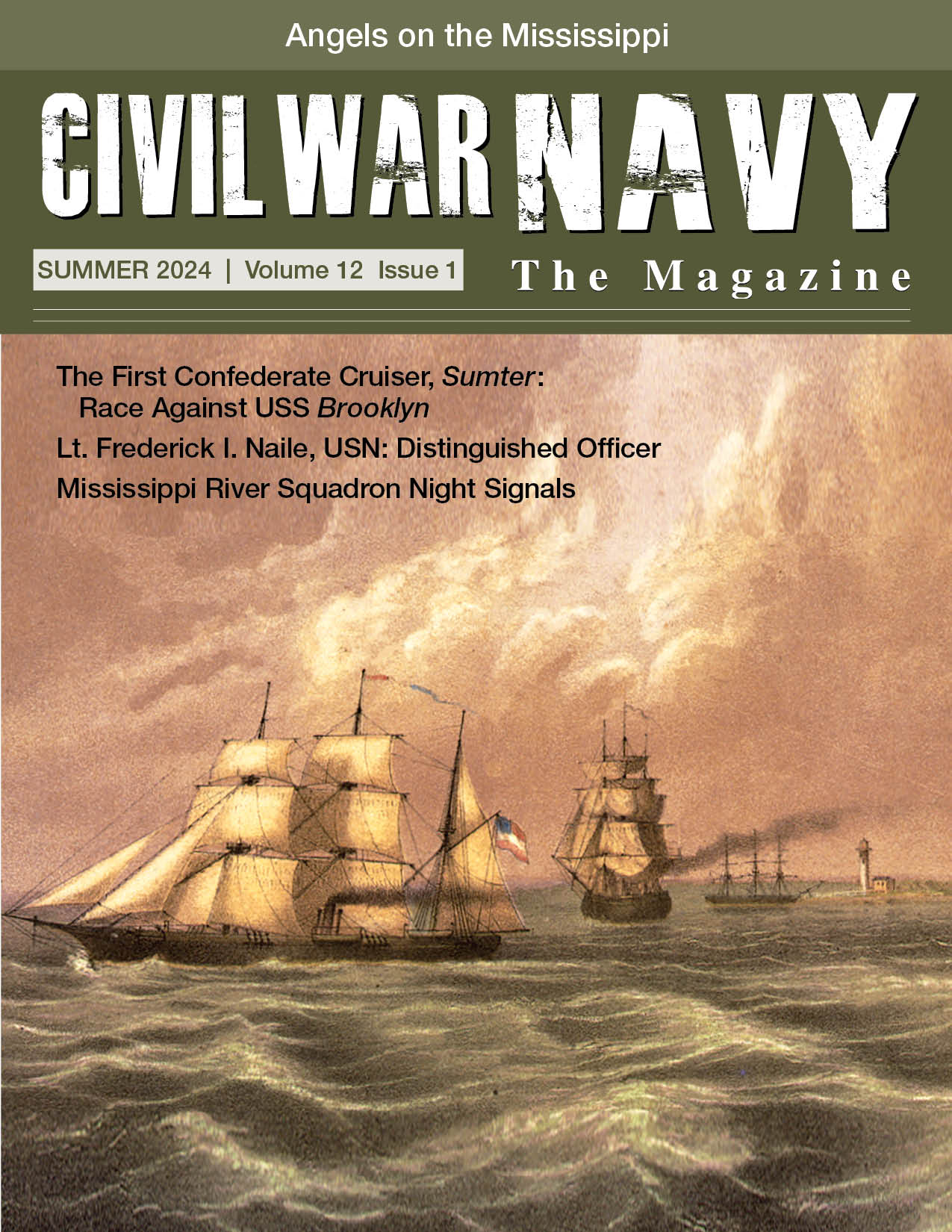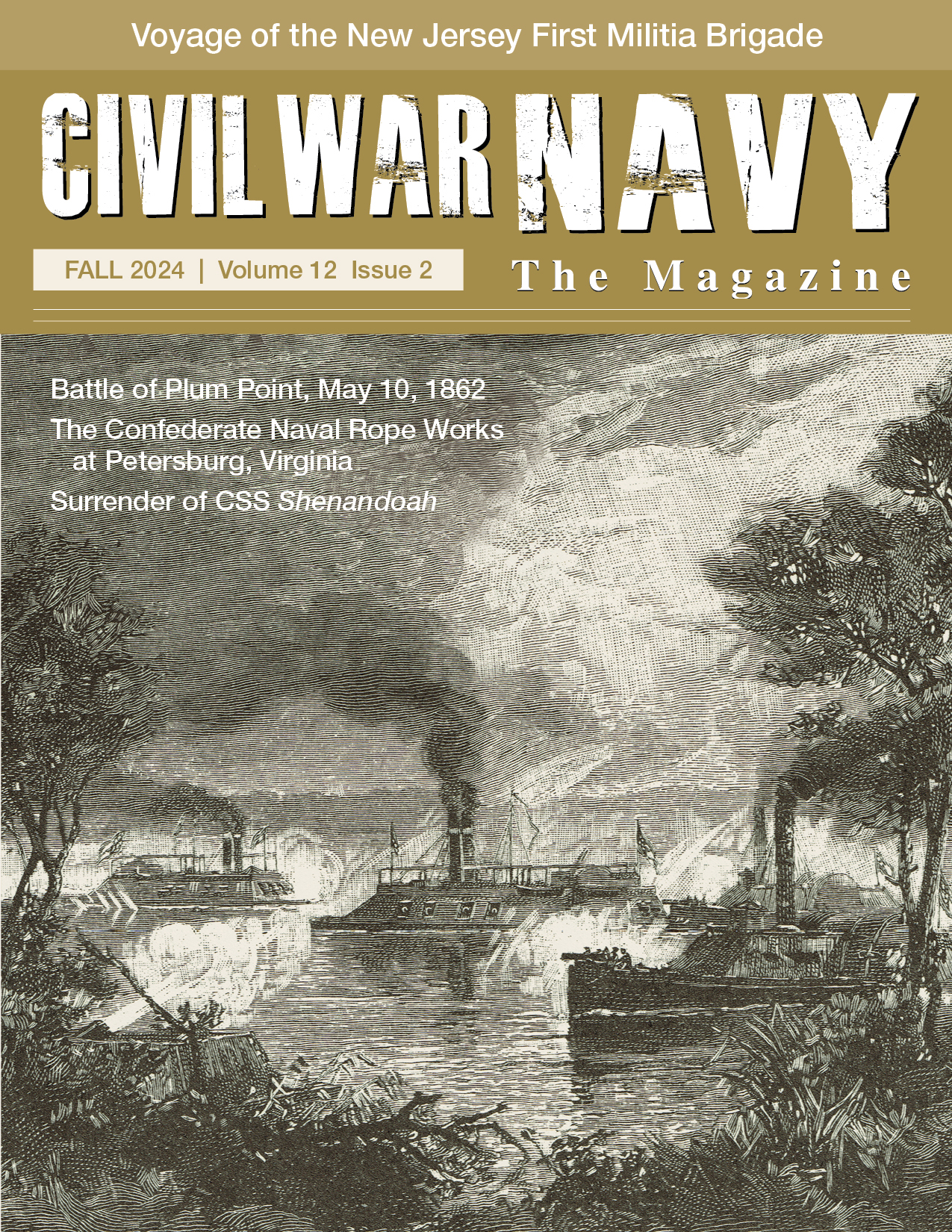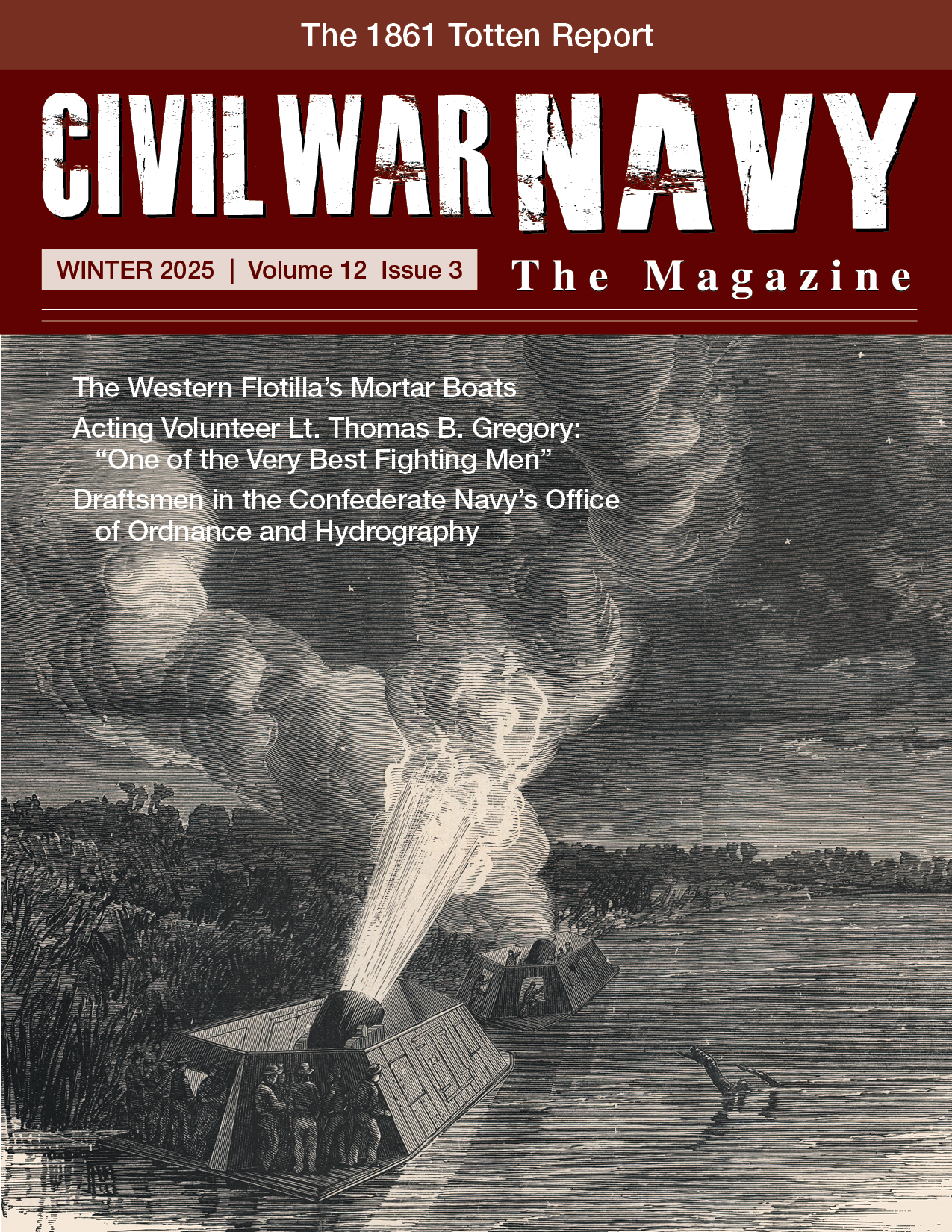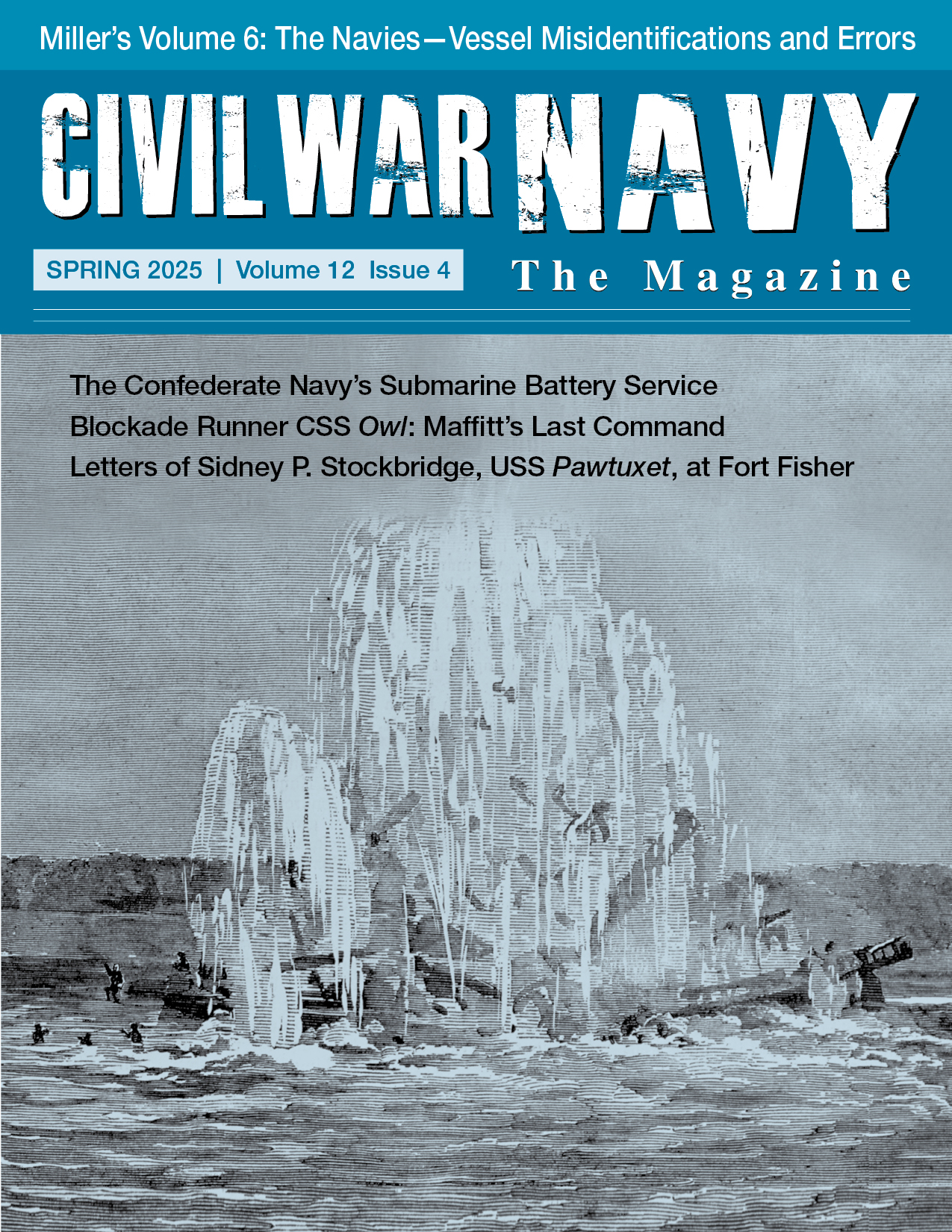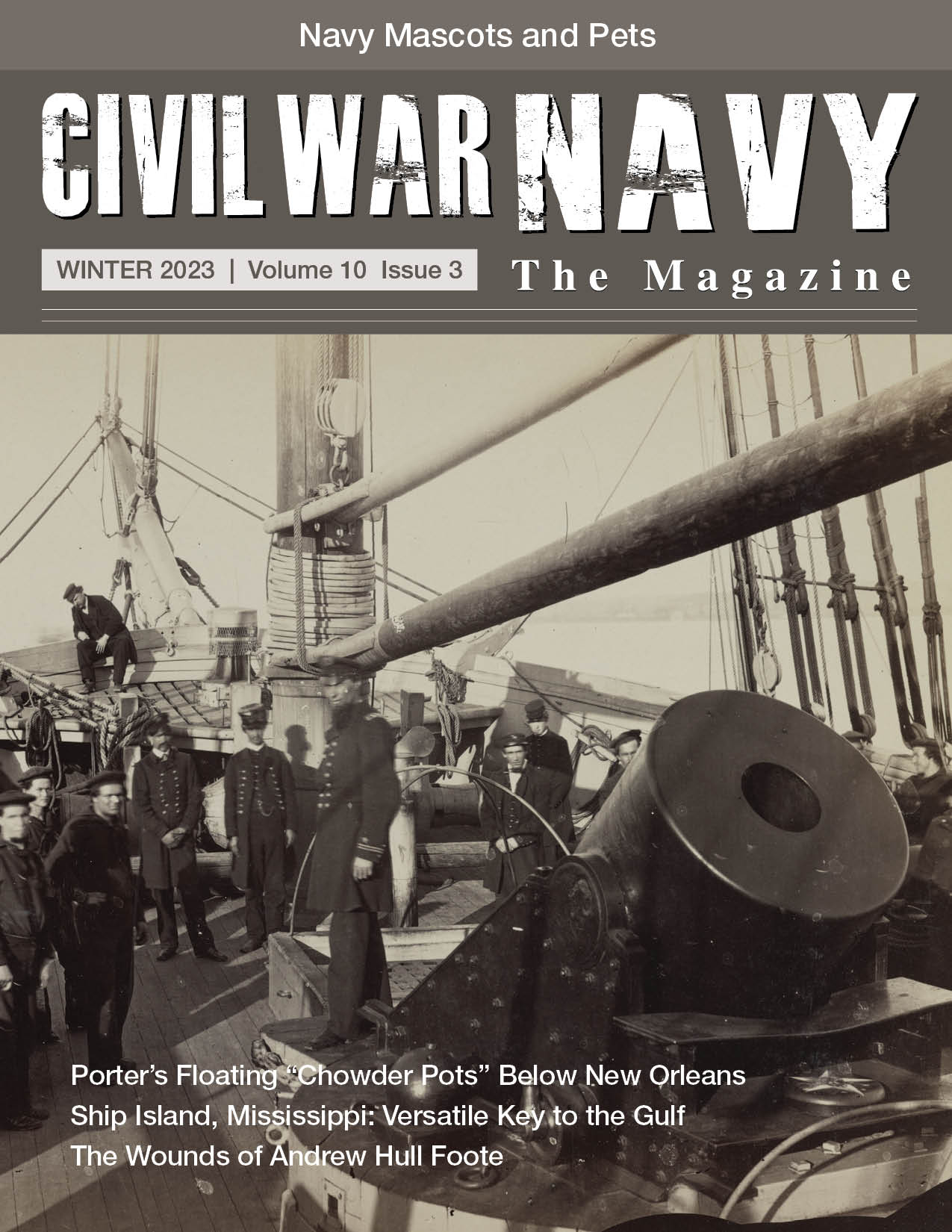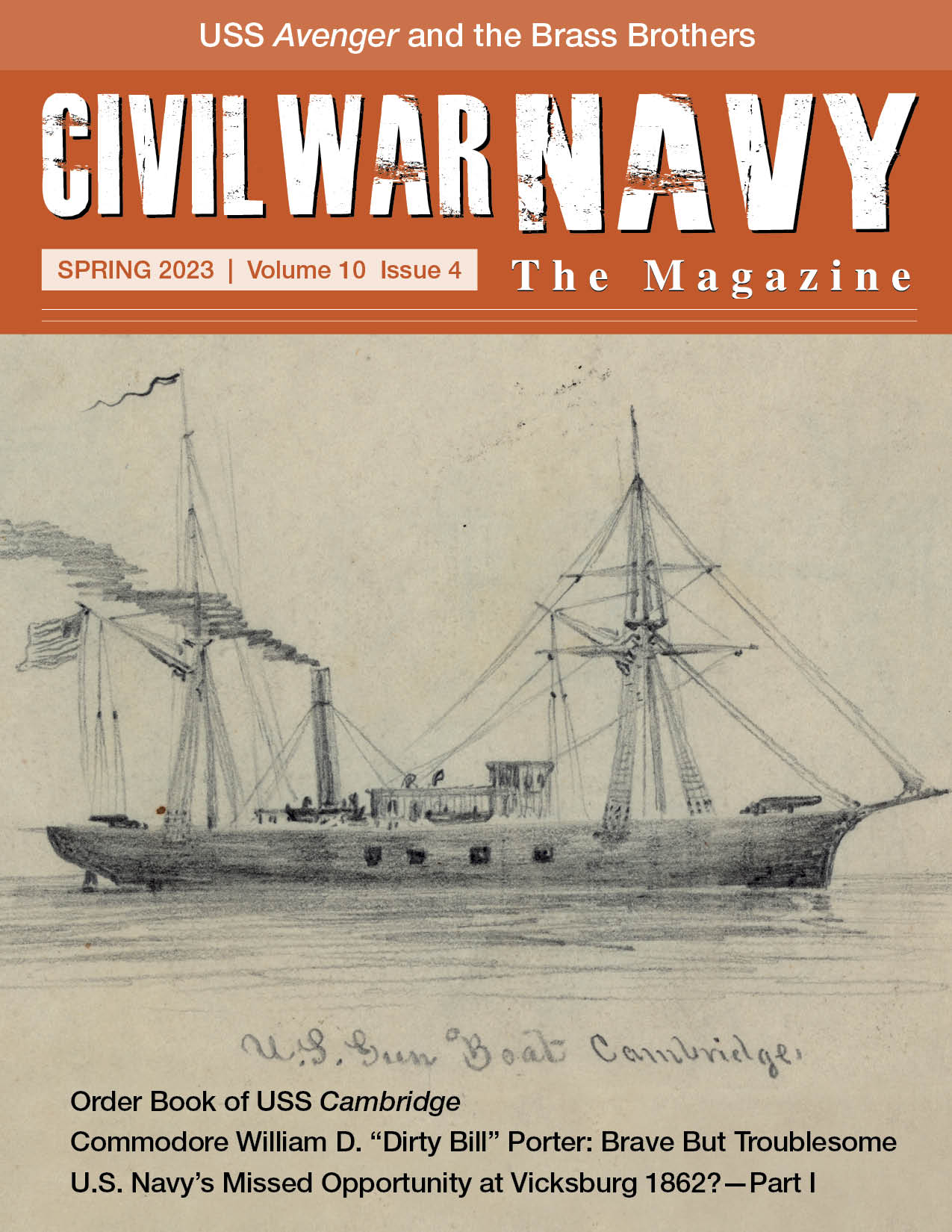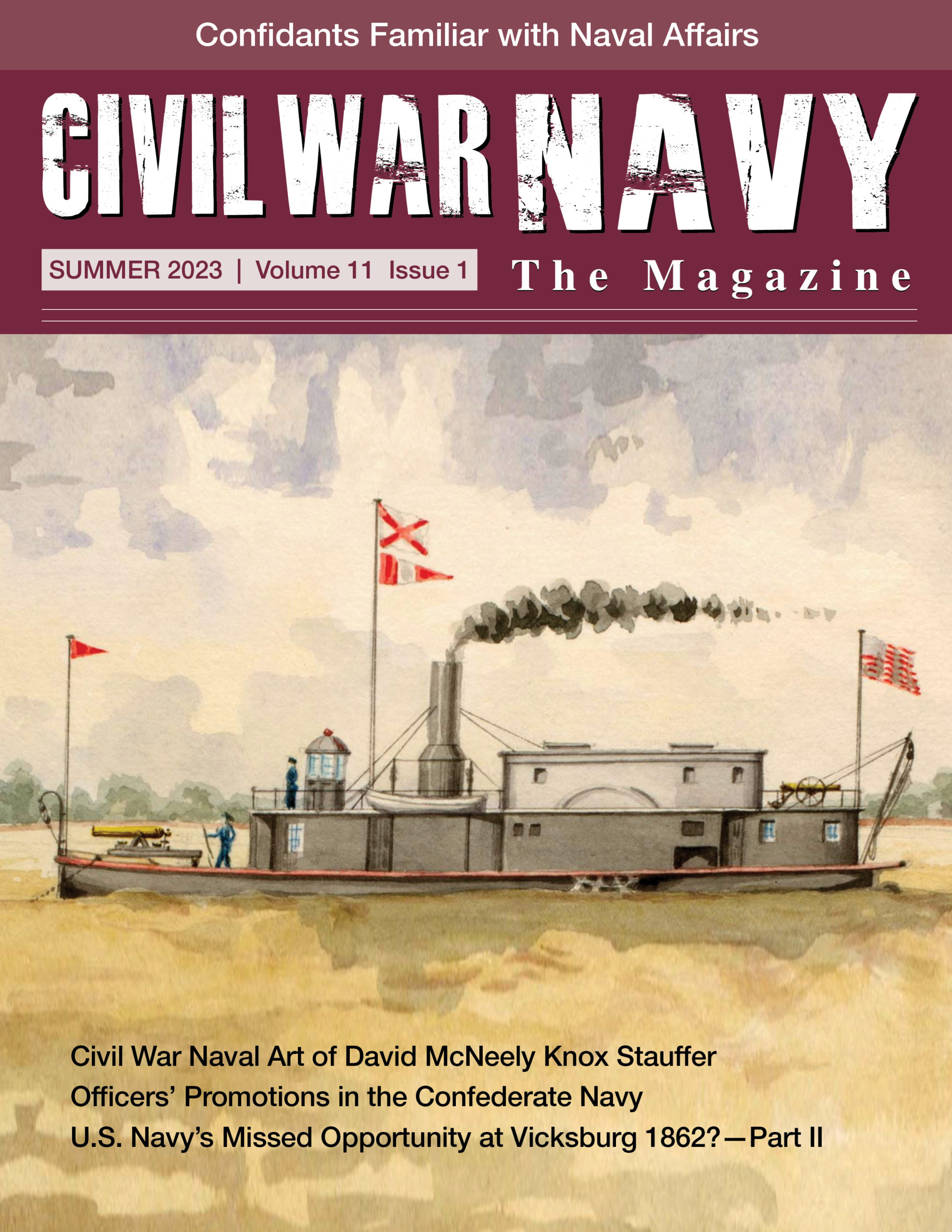Union Naval Yards & Stations
By
Neil P. Chatelain
Gary McQuarrie, Managing Editor
OVERVIEW
When the Civil War started, there were ten major naval yards and stations across the country. These ranged in size and capacity, with the largest being at the Gosport Navy Yard in Virginia, the Portsmouth Navy Yard in Maine, and the Brooklyn Navy Yard in New York.1,2 These yards built many dozens of warships and converted several hundreds of civilian vessels for wartime service.3 As Virginia and Florida seceded, the Confederates seized both the Gosport Navy Yard and the Warrenton Navy Yard, respectively, but both were recaptured in 1862. Other Southern yards, such as at Key West, Florida, never fell to Confederate forces. Naval facilities expanded during the war, with improvised yards established at Port Royal Sound, South Carolina, to support blockading operations. Yards were also formed at Cairo and Mound City, Illinois to support inland river operations. Naval facilities within the borders of the Confederacy, such as those at Pensacola and Key West, Florida, Port Royal Sound, South Carolina, the Gosport Navy Yard in Virginia, as well as the yards at Cairo and Mound City, were subordinate commands of the squadrons they supported. Navy yards in northern territory coordinated operations with the Navy Department and Secretary of the Navy Gideon Welles and Assistant Secretary of the Navy Gustavus Fox. In northern territory, the station commander typically oversaw recruiting, storehouses, hospitals, marine detachments, ordnance works, and naval construction and received all local requisitions, handling administrative matters and inspecting commissioned vessels in port—they did not have operational control over navy squadrons unless so instructed by the secretary, but often dispatched individual vessels on their own authority to comply with orders from Washington.
The principal naval yards and stations of the Union are summarized below, organized by state, along with some key facts and some additional documentary sources. The summary is not intended to be a comprehensive list of the all of the shipbuilding facilities, yards, and locations utilized by the North during the war.
References
1. Kenneth W. Munden and Henry Putney. The Union: A Guide to Federal Archives Relating to the Civil War (Washington DC: National Archives and Records Administration, 1998), p 492-493.
2. John H. Eicher and David J. Eicher. Civil War High Commands (Stanford, CA: Stanford University Press, 2001), p 79-80.
3. Paul H. Silverstone. Civil War Navies 1855-1883 (Annapolis, MD: Naval Institute Press, 2001).
MAINE
Portsmouth (Kittery) Navy Yard
Built on Fernald’s Island on the Piscataqua River on the border between New Hampshire and Maine, ships were first constructed at this site in 1695. As an American naval yard, it constructed ten warships before the Civil War. During the war, another 23 warships (including Mahaska, Sebago, Conemaugh, Pawtucket, Sassacus, Ossipee, Sacramento, Nipsic, Shawmut, and Sonoma) were constructed in the yard’s facilities, which employed over 2,400 contractors throughout the conflict. The Mohican-class screw sloop Kearsarge was laid down here in 1861 and commissioned in 1862. The Kalamazoo-class monitor Passaconaway was also laid down here in 1863, but construction was suspended in late 1865 though the monitor Agamenticus was built and commissioned here in 1864. Portsmouth Navy Yard also served as a repair and supply station for blockading ships needing a refit and overhaul.
Commanders
—George F. Pearson, October 1, 1860-September 30, 1864
—Theodorus Bailey, September 30, 1864-1867
Additional Information
William E. Whyte III. Portsmouth Navy Yard. The Civil War Naval Encyclopedia (Santa Barbara, CA: ABC-CLIO, 2011), Volume 1, p 538.
MASSACHUSETTS
Charlestown (Boston) Yard
Situated where the Mystic and Charles Rivers merge, the Charlestown Navy Yard, commonly called the Boston Navy Yard, held one of the few precious naval dry-docks before the war. This dry-dock made the Charlestown yard one of the most important in the U.S., especially after the Gosport Navy Yard fell to the Confederacy. Nineteen ships were constructed there (including Wachusett, Housatonic, Canandaigua, Pequot, Saco, Maratanza, Genesee, and Tioga) and 43 purchased vessels were equipped at the yard during the war. The yard served as a major supply station for the North Atlantic Blockading Squadron. The double-turreted monitor USS Monadnock was laid down here and commissioned in 1864. The Kalamazoo-class monitor Quinsigamond was also laid down here in 1864, but construction was suspended in late 1865. The yard also held a hospital and the USS Ohio, one of three old ships of the line reconstituted as receiving ships to process and train new recruits and manufactured anchor chain and rope.
Commanders
—William L. Hudson, April 30, 1859-June 3, 1862
—John B. Montgomery, June 3, 1862-1863
—Silas H. Stringham, December 15, 1863-1866
Additional Information
Robert A. Lynn and William E. Whyte III. Boston Navy Yard. The Civil War Naval Encyclopedia (Santa Barbara, CA: ABC-CLIO, 2011), Volume 1, p 75-76.
Kenneth W. Munden and Henry Putney. The Union: A Guide to Federal Archives Relating to the Civil War (Washington, DC: National Archives and Records Administration, 1998), p 494.
RHODE ISLAND
Newport Navy Yard
With the loss of the Gosport and Warrenton Navy Yards to the Confederacy in 1861, Union officials began looking for a replacement yard. They selected a site on Narragansett Bay in August or September 1861. Additionally, the U.S. Naval Academy was moved to Newport, Rhode Island, during the war to protect it should unrest occur in Annapolis, Maryland. After the war, in 1869, a formalized yard was created at Goat Island to construct torpedo boats. Later, the Naval War College was founded there as well.
Commanders
—George S. Blake, Superintendent of U.S. Naval Academy, September 15, 1857-September 9, 1865
Additional Information
“A New Navy Yard,” Burlington Weekly Free Press (Burlington, VT), September 6, 1861, p 1, col 7.
NEW YORK
Brooklyn Navy Yard
The Brooklyn Navy Yard, often just referred to as the New York Navy Yard, was one of America’s largest at the start of the Civil War. The extensive yard encompassed over 130 acres of land and possessed shipyards, a dry-dock, a hospital and a floating dock. The old ship of the line USS North Carolina, served as a receiving ship for processing and training new recruits. It also served as a supply and repair station for blockading ships and supported the 46 shipbuilding firms across New York City. Employing 5,000 workers by the end of the war, the Brooklyn Navy Yard built a number of warships, including Oneida, Adirondack, Lackawanna, Ticonderoga, Maumee, Nyack, Tallapoosa, and Octorara and converted several hundreds of civilian ships for wartime service and hosted the Russian Navy in 1863. The monitor Kalamazoo was laid down here in 1863, but construction was suspended in 1865, though the monitor Miantonomoh was built and commissioned here in 1865. It was one of the most important naval facilities in the Union war effort.
Commanders
—Samuel L. Breese, November 1, 1858-February 1861
—Andrew H. Foote, February 1861-June, 1861
—Hiram Paulding, October 25, 1861-May 1, 1865
—Charles H. Bell, May 1, 1865-1868
Additional Information
William E. Whyte III. Brooklyn Navy Yard. The Civil War Naval Encyclopedia, (Santa Barbara, CA: ABC-CLIO, 2011), Volume 1, p 82-83.
Kenneth W. Munden and Henry Putney. The Union: A Guide to Federal Archives Relating to the Civil War (Washington, DC: National Archives and Records Administration, 1998), p 495.
Sackets Harbor Navy Station
Located on Lake Ontario, Sackets Harbor became the headquarters for naval operations on the Great Lakes in the War of 1812 and nearly a dozen warships were built there during that war. Afterwards, the shipyard continued operations, constructing vessels until 1874, United States Revenue Cutter Active, completed in 1847 and a formalized naval station forming near the shipyard the next year. During the Civil War, the yard mainly served as a collection point for sailors enlisting from upper New York and as a supply and repair station for Union vessels on the Great Lakes. The army also maintained a recruiting and training camp nearby.
Commanders
—Josiah Tattnall, 1860-February 21, 1861
—Elie A.F. Lavallette, February 21, 1861-July 1862
—Theodorus Bailey, July 1862-November 1862
Additional Information
“Sackets Harbor Naval Station House,” Watertown Daily Times (Watertown, NY), May 24, 1947. Roswell P. Flower Memorial Library. New York Heritage Digital Collections.
PENNSYLVANIA
Philadelphia Navy Yard
The small Philadelphia Navy Yard was in operation since 1800. Housing two floating dry-docks, completed construction of eight warships (including Tuscarora, Juniata, Shenandoah, Kansas, Yantic, Monongahela, Miami, and Tacony) during the Civil War. The Kalamazoo-class monitor Shackamaxon was laid down here in 1863, but construction was suspended in 1865, though the monitor Tonawanda was built and commissioned here in 1865. The yard also held the Naval Asylum for disabled and infirm sailors. The Philadelphia Navy Yard performed repair and overhaul maintenance for vessels of the North Atlantic Blockading Squadron.
Commanders
—Samuel F. Du Pont, 1855-1861
—James L. Lardner, June 1861-September 1861
—Thomas Turner, September 1861-October 1861
—Garrett J. Pendergrast, October 1861-November 1862
—Cornelius K. Stribling, November 1862-November 1864
—John B. Hull Jr., November, 1864-1865
—John P. Gillis, 1865
—Edward W. Carpenter, 1865-1866
Additional Information
William E. Whyte III. Philadelphia Navy Yard. The Civil War Naval Encyclopedia (Santa Barbara, CA: ABC-CLIO, 2011), Volume 1, p 516.
MARYLAND
Baltimore Naval Station
The Baltimore station provided repair and support facilities for naval operations in the Chesapeake Bay and for vessels of the North Atlantic Blockading Squadron. It also operated the USS Alleghany, a receiving ship used to train newly enlisted recruits.
Commanders
—Thomas A. Dornin, May 1862-December1865
Additional Information
Kenneth W. Munden and Henry Putney. The Union: A Guide to Federal Archives Relating to the Civil War (Washington, DC: National Archives and Records Administration, 1998), p 494.
DISTRICT OF COLUMBIA
Washington Navy Yard
The Washington Navy Yard, lying on the Anacostia River, served as a major supply and repair station for Union ships, as well as the dock of entry for trips President Lincoln would take to the front lines, as he did in the summer of 1862, the summer of 1864, and the spring of 1865. In fact, President Lincoln became close friends with John A. Dahlgren while he oversaw the yard in the war’s first year. Dahlgren helped the yard become a specialized location for testing naval ordnance. It contained storehouses, cranes, and warehouses crowded with hundreds of workers. Thanks to its proximity to the capital, politicians, civilian leadership within the Navy Department, and the most senior naval officers often spent time there, supervising work, conducting engineering tests, or overseeing repairs. The facilities also acted as homeport for the Potomac Flotilla. Right after the Battle of Hampton Roads and its engagement with CSS Virginia, USS Monitor put into the yard for repairs and alterations.
Commanders
—Franklin Buchanan, May 26, 1859-April 22, 1861
—John A. Dahlgren, April 22, 1861-July 22, 1862
—Andrew A. Harwood, July 22, 1862- December 31, 1863
—John B. Montgomery, December 31, 1863-1864
—William Radford, October 10, 1865-1869
Additional Information
Anna Gibson Holloway and Jonathan W. White. The Monitor at the Washington Navy Yard. Civil War Navy—The Magazine, Volume 6, No. 2, Fall 2018, p 47-54.
Edward J. Marolda. The Washington Navy Yard: An Illustrated History (Washington, DC: Naval Historical Center, 1999), p 21-34.
Kenneth W. Munden and Henry Putney. The Union: A Guide to Federal Archives Relating to the Civil War (Washington, DC: National Archives and Records Administration, 1998), p 498.
VIRGINIA
Gosport (Norfolk) Navy Yard
The Gosport Navy Yard located in Portsmouth, across the Elizabeth River from the larger city of Norfolk, was abandoned by the Union, with many vessels set afire and scuttled, and captured by the Confederates on April 20, 1861. At the time, it was one of the finest navy yards of the United States and had the oldest continuously operating dry dock in the country. Its capture resulted in almost 1,100 heavy guns and a large amount of war material. The hull of the burned-out USS Merrimack was used to construct the CSS Virginia, the Confederates’ first ironclad. Gosport was also a naval ordnance facility while the Confederates held it. In May 1862, the Confederates burned the navy yard when they were forced to leave it and it was reoccupied by Union forces; after this, the “Gosport” name was dropped and it was renamed Norfolk Navy Yard to avoid confusion with the Portsmouth Naval Shipyard in Portsmouth, Maine.
Commanders
—Charles S. McCauley, August 1, 1860-April 20, 1861
—John W. Livingston, May 20, 1862-1864
—John M. Berrien, November 16, 1864-1865
—John J. Glasson, 1865
—Robert B. Hitchcock, October 31, 1865-1866
Additional Information
John V. Quarstein. The Capture of Gosport Navy Yard. Civil War Navy—The Magazine, Volume 5, No. 4, Spring 2018, p 13-23.
SOUTH CAROLINA
Port Royal Sound Naval Station
After being captured by Union forces in late 1861, Port Royal Sound became a major anchorage, supply station, and emergency repair station for the South Atlantic Blockading Squadron. It also served as a harbor of refuge during heavy weather along the coastline. Port Royal was also the location for two temporary monitor repair and maintenance ‘Port Royal Working Parties‘ in 1863 and 1864, the first aboard the commercial screw steamer Relief, and the second aboard the private commercial steamer Commander—these vessels had dozens of skilled workers with special tools, supplies, and spare parts to effect repairs, modifications, and even overhauls to the monitors serving the South Atlantic Blockading Squadron—they also helped to defoul the monitors. After the war, facilities were expanded and the Marine Corps Recruit Depot at Paris Island was established there.
Commanders
—Samuel F. Du Pont, November 1861-July 5, 1863
—John A Dahlgren, July 5, 1863-1865
Additional Information
Lawrence S. Rowland. Port Royal Naval Station. South Carolina Encyclopedia, http://www.scencyclopedia.org/sce/entries/port-royal-naval-station/.
Dana Wegner. The Port Royal Working Parties, Civil War Times Illustrated, Volume XV, No. 8, December 1976, p 22-31.
FLORIDA
Key West Navy Yard
A naval station was established at Key West in 1823 to combat piracy. During the Civil War, it became a coaling, supply, and repair station for the East Gulf Blockading Squadron, as well as the West India Squadron. By the end of the war, 80 machinists were employed at the yard, which had to deal with a severe outbreak of yellow fever in 1864.
Commanders
—Theodorus Bailey, November 1862-1864
Additional Information
The United States Navy and the City of Key West, Florida (Key West, FL: The Key West Press, 1953), p 5.
Warrenton (Pensacola) Navy Yard
First established in 1825, it was the ninth navy yard established in the United States and the only one on the Gulf of Mexico at the time. By 1850, a naval hospital and dry-dock had been established. The Hartford-class screw sloop Pensacola was constructed here and after being towed to the Washington Navy Yard, was commissioned in late 1861. Following Florida’s secession, the yard was surrendered to the Confederates on January 12, 1861, who occupied it from 1861-1862; when they left in May 1862, they burned much of what remained standing and Union forces reoccupied the yard. It then became the homeport for the West Gulf Blockading Squadron, and despite its limited heavy machinery, it served as that squadron’s supply and repair station.
Commanders
—James Armstrong, October 30, 1860-January 12, 1861
—William Smith, December 29, 1862-October 6, 1864
—James Armstrong, October 6, 1864-1868
Additional Information
Virginia Parks, Alan Rick, and Norman Simmons. Pensacola and the Civil War. Pensacola Historical Society Quarterly, Volume 9, No. 2, Spring 1978, p 12-29.
Kenneth W. Munden and Henry Putney. The Union: A Guide to Federal Archives Relating to the Civil War (Washington, DC: National Archives and Records Administration, 1998), p 496.
MISSISSIPPI
Ship Island
A barrier island off the coast of Mississippi, Ship Island was recognized early as a strategic location. Before the war, work began on Fort Massachusetts, and a joint Confederate Army-Navy-Marine effort briefly occupied the island in mid-1861. Union forces occupied the island in September 1861 and it immediately became a critical supply and staging area for Flag Officer David Farragut’s Western Gulf Blockading Squadron for the campaign against New Orleans in the Spring of 1862. The island remained a support facility and supply storage area, as well as a makeshift prison for Confederate prisoners, for the rest of the war, though in August 1862 the Western Gulf Blockading Squadron shifted its principal homeport to Pensacola, Florida.
Commanders
—David Farragut, May 1862-1864
Additional Information
Zed H. Burns. Ship Island and the Confederacy (Hattiesburg, MS: University and College Press of Mississippi, 1971).
LOUISIANA
New Orleans
Though not a formalized naval station, New Orleans was utilized by Union naval forces as a supply and repair station, concentrating on assisting vessels of the West Gulf Blockading Squadron and the Mississippi River Squadron. After the capture of New Orleans in April 1862, Union naval forces repurposed the numerous civilian shipyards and dry-docks for their own use, helping to maintain the blockade and gain control over the remainder of the Mississippi River. Captured Confederate vessels, such as the CSS Tennessee from the Battle of Mobile Bay in 1864, were sent here for overhaul and repair. The naval facilities remained under the charge of the commander of the West Gulf Blockading Squadron.
Commanders
—David Farragut, May 1862-1864
Additional Information
Chester G. Hearn. The Capture of New Orleans 1862 (Baton Rouge, LA: Louisiana State University Press, 1995).
ILLINOIS
Cairo Navy Yard
In 1861, a navy yard was established at Cairo, Illinois, at the confluence of the Ohio and Mississippi Rivers. Here supplies were stored and plans made for advances down the Mississippi River. Army volunteers from Charles R. Ellet’s Marine Brigade guarded the station until Union marines arrived in November 1862. The yard served as a concentration point for supplies, a staging point for the Mississippi River Squadron, and a makeshift repair yard for damaged warships. By late 1863, however, it was becoming too large. A survey completed in March 1864 recommended relocating the yard to somewhere with more space to operate and by May 1864, the Cairo yard was moved to Mound City, Illinois.
Commanders
—Andrew H. Foote, 1861-1862
—David D. Porter, 1863-1864
Additional Information
Ron Field. Cairo and Mound City Naval Station. Civil War Navy—The Magazine, Volume 4, No. 4, Spring 2019, p 51-56.
Mound City Navy Yard
In 1861, James B. Eads leased land at Mound City, Illinois, several miles up the Ohio River from Cairo. There, he oversaw construction of several City-class ironclads, including the USS Cairo, USS Cincinnati, and USS Mound City. (other City-class ironclads were built in St. Louis, and Carondelet.) After that, Mound City’s wharves saw continuous service and often held the flagship of the Mississippi River Squadron. In March 1864, the naval station at Cairo, Illinois was determined to be too small and unable to handle the amount of supplies flowing through the area and a new station at Mound City was established, with most of the Cairo station’s supplies transferred to Mound City by May 9, 1964. It was guarded by a battalion of over 150 marines. Work was suspended at the yard in June 1865, with supplies transferred to the Pensacola Navy Yard and the receiving and ordnance ships docked there sold at auction, though the station officially remained open until 1875.
Commanders
—Andrew H. Foote, 1861-1862
—David D. Porter, 1863-1864
Additional Information
Ron Field. Cairo and Mound City Naval Station. Civil War Navy—The Magazine, Volume 4, No. 4, Spring 2019, p 51-56.
CALIFORNIA
Mare Island (San Francisco) Navy Yard
The Mare Island Navy Yard was the first naval station on the West Coast, established north of San Francisco at Vallejo, California. During the Civil War, it served as the repair and overhaul station for the Pacific Squadron. The USS Saginaw was built there from 1858-1860 and the ironclad monitor USS Camanche was assembled there towards the end of the war. A battalion of marines was dispatched to protect the yard, arriving in 1863; in the meantime, 150 yard contractors often drilled and were called in emergencies as a makeshift defense force. In 1863, the Russian Navy sent part of its fleet to California, and it headquartered at the Mare Island Navy Yard.
Commanders
—David McDougal, March 13, 1861-June 4, 1861
—William H. Gardner, June 4, 1861-May 27, 1862
—Thomas O. Selfridge, May 27, 1862-October 17, 1864
—David McDougal, October 17, 1864-1869
Additional Information
Robert Erwin Johnson. Thence Round Cape Horn (Annapolis, MD: United States Naval Institute, 1963), p 119.
Spencer C. Tucker. Mare Island Navy Yard. The Civil War Naval Encyclopedia (Santa Barbara, CA: ABC-CLIO, 2011), Volume 1, p 369-370.

